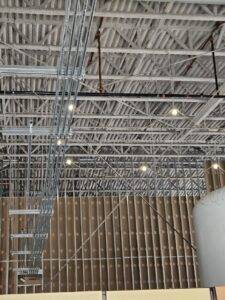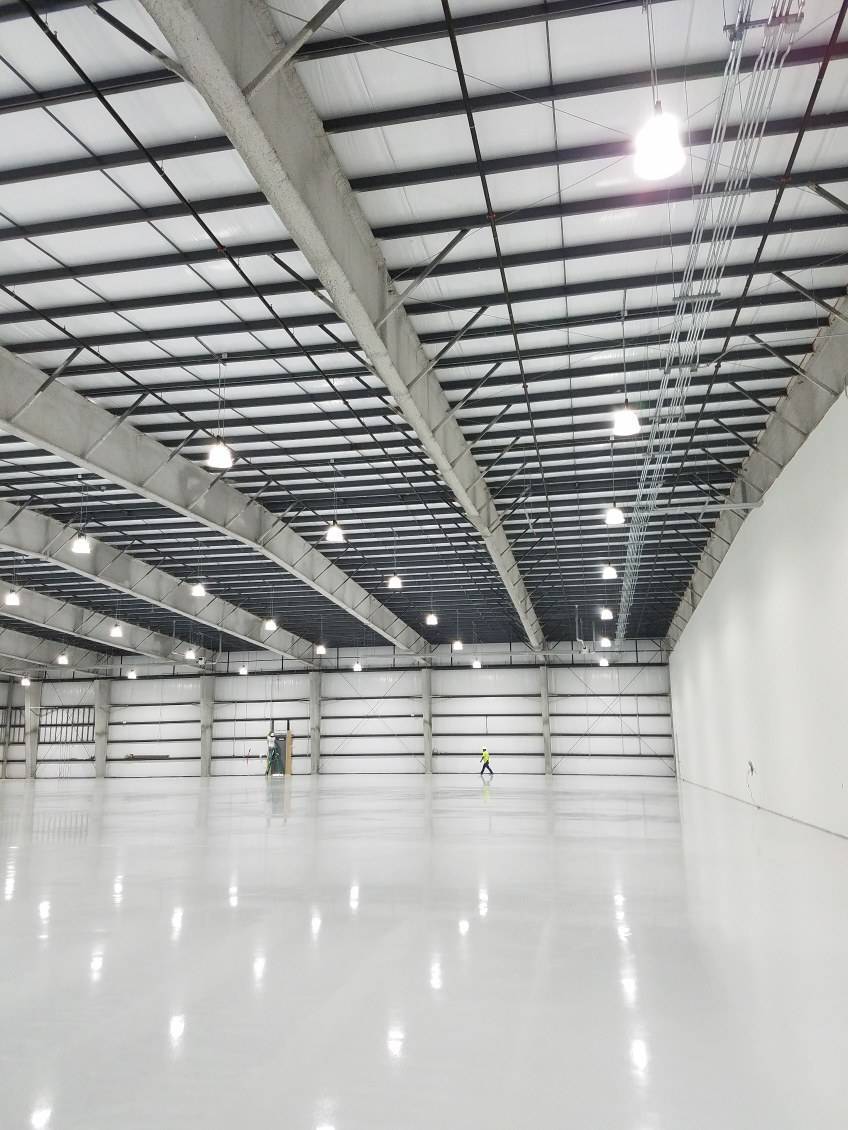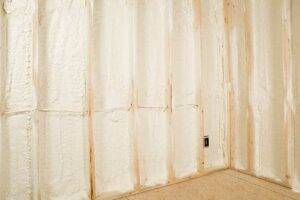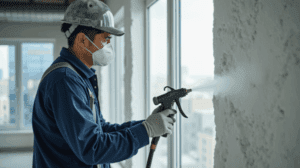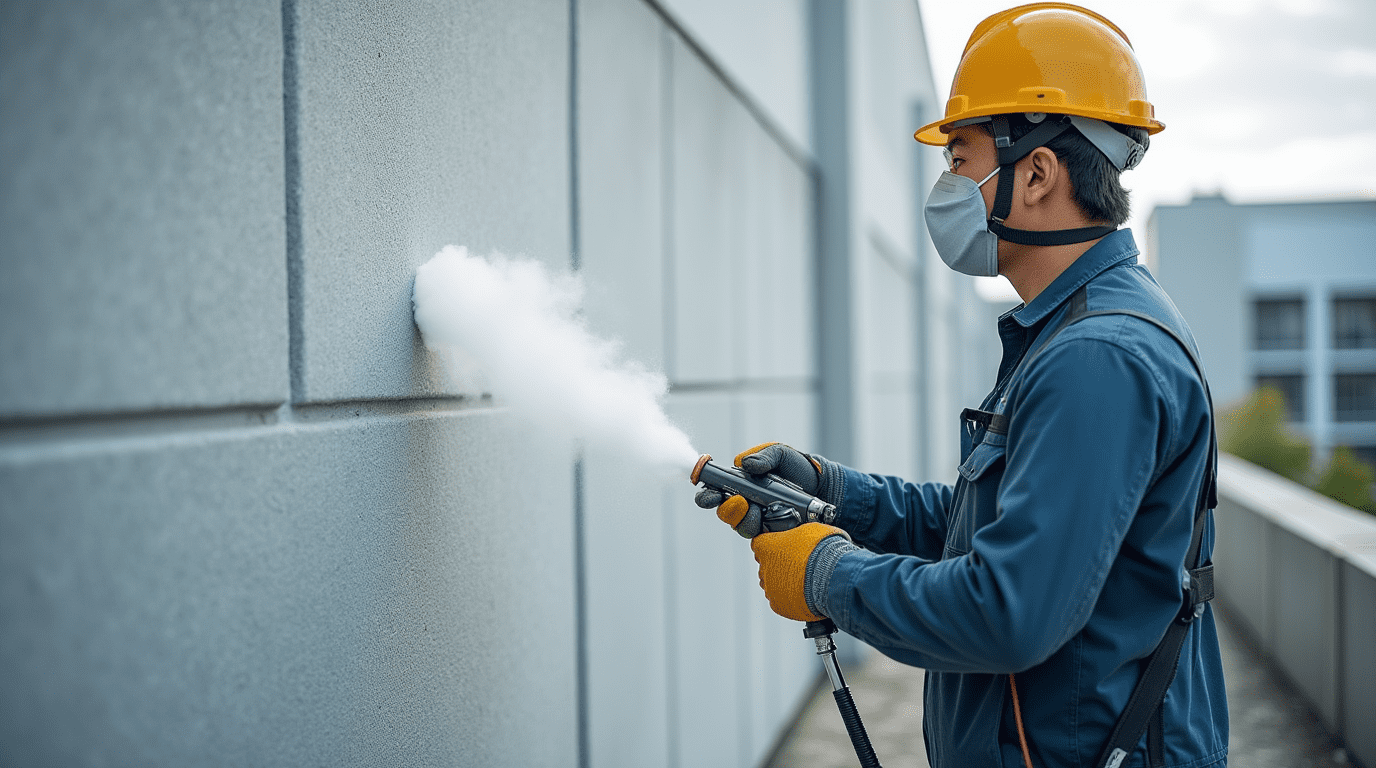K-13 Insulation Price Comparison for Smart Savings
Bahl Fireproofing
Choosing the right insulation for your commercial or industrial facility isn’t just about upfront costs. It’s about understanding total value over the life of your building. When facility managers and contractors compare K-13 sprayed cellulose insulation against alternatives like spray foam, fiberglass, and mineral wool, the real question becomes: which material delivers the best return on investment while meeting both thermal and acoustic performance requirements?
TLDR: K-13 insulation typically costs $1.50 to $3.00 per square foot installed, positioning it between budget materials like fiberglass ($0.40 to $0.70) and premium closed-cell spray foam ($3.00 to $7.00). However, K-13’s 75-year lifespan, combined thermal and acoustic performance (R-3.7 per inch with NRC ratings up to 1.05), and minimal maintenance requirements often make it the most cost-effective choice for facilities requiring noise control alongside energy efficiency. With payback periods of 2 to 5 years and qualification for Section 179D tax deductions, K-13 delivers superior lifecycle value compared to materials requiring replacement or separate acoustic treatments.
The Hidden Cost Problem in Commercial Insulation
I’ve walked through hundreds of commercial facilities over the years, and I see the same pattern. A building owner chooses the cheapest insulation option upfront, usually fiberglass batts at $0.40 per square foot. Ten years later, they’re facing a complete tear-out and replacement because the material has compressed, absorbed moisture, or simply worn out. Meanwhile, their HVAC system has been working overtime, and employee complaints about noise never stopped.
The real cost of insulation isn’t what you pay at installation. It’s what you pay over 20, 50, or 75 years of building operation. That includes energy bills, maintenance calls, replacement costs, and lost productivity from poor acoustic control. Smart facility managers know this. They compare total cost of ownership, not just installation bids.
Understanding K-13’s Cost Position in the Market
K-13 sprayed cellulose insulation sits in the middle of the commercial insulation price spectrum. At $1.50 to $3.00 per square foot installed, it costs more than basic fiberglass batts or blown-in cellulose, but significantly less than closed-cell spray foam or mineral wool acoustic panels. What makes K-13 spray-applied insulation unique is that you’re getting two systems in one application: thermal insulation with an R-value of 3.7 per inch and acoustic control with noise reduction coefficients (NRC) ranging from 0.90 to 1.05 at appropriate thicknesses.
Compare this to closed-cell spray foam at $3.00 to $7.00 per square foot. Yes, you get higher R-values (R-5 to R-7 per inch), but the acoustic performance is poor, with NRC ratings around 0.70. If your facility needs sound control, you’ll need to add separate acoustic treatments, doubling your investment. K-13 eliminates that second installation, which is why gymnasiums, call centers, and manufacturing facilities often find it delivers better value than premium spray foam options.
Blown-in cellulose offers lower upfront costs at $0.70 to $0.80 per square foot, making it attractive for budget-conscious projects. However, it requires periodic maintenance, settling over time and needing topping or raking to maintain performance. K-13’s spray application creates a seamless, monolithic installation that maintains its thickness and performance for 75 years without settling or maintenance requirements.
K-13 vs Spray Foam: When to Choose Each
The spray foam versus K-13 decision usually comes down to your facility’s primary needs. Closed-cell spray foam excels in applications requiring maximum thermal resistance and air sealing, such as cold storage facilities and buildings in extreme climates, but costs significantly more at $3.00 to $7.00 per square foot. Open-cell spray foam costs $1.00 to $4.50 per square foot, similar to K-13, but its acoustic performance is moderate at best. K-13’s NRC rating of 1.00 to 1.05 provides measurably better sound absorption than open-cell foam’s typical NRC of 0.70. According to Energy.gov’s insulation guide, the key to choosing insulation is matching material properties to building requirements. For facilities needing both thermal and acoustic performance, K-13 delivers that combination in a single application.
R-Value Cost Efficiency: Comparing Thermal Performance Per Dollar
When evaluating insulation strictly on thermal performance, cost per R-value provides a useful metric. For a standard 2-inch application, K-13 delivers approximately R-7.4 total (R-3.7 per inch), costing $0.27 to $0.34 per R-value point. Blown-in cellulose offers the best thermal cost efficiency at $0.18 to $0.25 per R-value, while closed-cell spray foam costs $0.43 to $0.67 per R-value point. However, this metric alone doesn’t capture K-13’s dual functionality. When you need both thermal insulation and acoustic control, you’d need to add the cost of separate acoustic treatment to materials like spray foam or cellulose. K-13’s combined performance eliminates that additional cost.
Total Cost of Ownership: The 75-Year Analysis
Lifecycle cost analysis changes the insulation comparison dramatically. K-13’s 75-year lifespan means one installation serves the building’s entire useful life, eliminating recurring replacement costs and building disruption. The material maintains its thickness and performance without settling or compression. For occupied facilities, this elimination of recurring work has real value beyond the dollar figures, avoiding the labor access challenges and building disruption associated with repeated maintenance or replacement cycles that other materials may require.
Energy Savings and ROI: When Does Insulation Pay for Itself?
Payback period calculations help facility managers justify insulation investments. K-13 typically achieves payback in 2 to 5 years in commercial applications, with facilities upgrading from minimal insulation seeing energy cost reductions of 20 to 30 percent, though results vary based on climate zone, building envelope quality, and HVAC system efficiency. Over 10 years, return on investment typically ranges from 150 to 250 percent. According to ASTM testing standards, insulation performance should be evaluated under standardized conditions. Material degradation over time, moisture absorption, compression, and settling all affect long-term thermal performance. K-13’s monolithic spray application and resistance to settling help maintain its rated performance throughout its 75-year lifespan.
Tax Incentives: Section 179D Changes the Math
Federal tax incentives significantly impact insulation economics. The IRS Section 179D tax deduction allows building owners to deduct $0.50 to $5.00 per square foot for qualifying energy-efficient improvements to commercial buildings. K-13 applications that meet Section 179D requirements can qualify for these deductions, potentially reducing payback periods by 30 to 50 percent. Building owners should consult with tax professionals and energy modelers early in project planning to maximize benefits, as qualification depends on overall building energy performance improvements and proper documentation.
Acoustic Performance: Where K-13 Stands Out
Noise control in commercial and industrial facilities directly impacts productivity, occupant comfort, and building value. Materials with high NRC ratings absorb sound energy rather than reflecting it, reducing reverberation and ambient noise levels.
K-13 achieves NRC ratings of 0.90 to 1.05 depending on thickness and substrate configuration. At 2-inch thickness over solid backing, K-13 achieves NRC 1.00, while 1.5-inch applications on ribbed metal deck achieve NRC 1.05. This performance matches or exceeds mineral wool acoustic panels costing two to three times as much.
Spray foam, despite its thermal advantages, typically delivers lower acoustic performance than K-13. Manufacturer data shows open-cell foam NRC ratings around 0.70, meaning it reflects significant sound energy compared to K-13’s NRC 1.00 to 1.05, often requiring additional acoustic treatment in spaces with noise concerns. For facilities like gymnasiums, manufacturing plants with equipment noise, or call centers requiring speech privacy, spray foam alone doesn’t solve acoustic problems. Adding separate acoustic treatments eliminates spray foam’s cost advantage over K-13.
Fiberglass batts and blown-in cellulose offer moderate acoustic performance with NRC ratings from 0.80 to 0.95. While better than spray foam, they don’t match K-13’s performance, particularly in seamless installation that eliminates gaps and acoustic flanking paths.
In real-world commercial installations, K-13’s combined thermal and acoustic performance, delivered in a single application without settling, compression, or maintenance issues, often delivers superior lifecycle value compared to materials requiring periodic topping, replacement, or separate acoustic treatment.
For facility managers prioritizing noise control alongside thermal performance, K-13’s acoustic capabilities represent significant value. Reducing workplace noise improves productivity, decreases worker fatigue, and enhances occupant satisfaction. These benefits have real economic value, even if they’re harder to quantify than energy cost savings. For projects throughout our service areas in Texas, Kansas, and Oklahoma, material selection should account for regional climate conditions and local energy costs.
Common Questions About K-13 Cost and Value
How does K-13 pricing compare to spray foam for the same R-value?
K-13 costs approximately $1.50 to $3.00 per square foot at typical application thicknesses delivering R-7 to R-11 total. Closed-cell spray foam achieving similar R-values costs $3.00 to $7.00 per square foot, roughly double K-13’s price. However, K-13 provides superior acoustic performance (NRC 1.00 to 1.05 vs 0.70), making direct R-value comparison incomplete. If your facility needs both thermal and acoustic performance, K-13 often delivers better total value.
What makes K-13 more economical than fiberglass over time?
While fiberglass batts carry manufacturer lifespan ratings of 50 to 100 years, real-world thermal performance typically degrades within 15 to 20 years due to compression, moisture absorption, and settling. Facility managers often plan for supplemental insulation or replacement to maintain optimal energy efficiency. K-13’s 75-year lifespan with maintained performance means one installation serves the building’s entire useful life, eliminating recurring replacement costs and building disruption.
Does K-13 qualify for energy efficiency tax incentives?
Yes, K-13 applications can qualify for Section 179D federal tax deductions when they contribute to whole-building energy efficiency improvements meeting program requirements. Deductions range from $0.50 to $5.00 per square foot, depending on total energy savings achieved. However, Section 179D qualification depends on comprehensive energy modeling and meeting specific performance thresholds, not just insulation installation alone. Consult with tax professionals and energy modelers to determine eligibility for your specific project.
When should I choose closed-cell spray foam over K-13?
Closed-cell spray foam makes sense when maximum R-value per inch is critical, such as cold storage facilities, refrigerated warehouses, or buildings in extreme climates. Spray foam’s air sealing properties also benefit buildings with significant infiltration issues. However, if your facility requires noise control, spray foam’s lower acoustic performance (NRC around 0.70) means you’ll need separate acoustic treatments. For buildings requiring both thermal and acoustic performance, K-13 typically delivers better value.
Key Takeaways
The following analysis compares both manufacturer specifications and real-world performance data. Material lifespan ratings represent theoretical maximum longevity under ideal conditions. Actual performance depends on installation quality, building envelope design, maintenance, climate exposure, and occupancy patterns.
When comparing insulation options for commercial and industrial facilities, K-13 delivers strong value for buildings requiring both thermal and acoustic performance. At $1.50 to $3.00 per square foot installed, it costs less than closed-cell spray foam while providing superior sound absorption. Its 75-year lifespan eliminates the replacement costs associated with fiberglass batts, and its maintenance-free performance avoids the periodic topping required for blown cellulose.
Closed-cell spray foam offers higher R-values per inch but costs two to five times more than K-13 and requires separate acoustic treatment in noise-sensitive spaces. Blown-in cellulose provides the lowest upfront cost but needs ongoing maintenance and periodic topping. Fiberglass appears cheapest initially but may require supplemental insulation every 15 to 20 years to maintain thermal effectiveness. Mineral wool matches K-13’s acoustic performance but costs two to three times more.
Section 179D tax deductions can reduce K-13’s net cost by $0.50 to $5.00 per square foot when projects meet energy efficiency requirements. Payback periods of 2 to 5 years make K-13 financially attractive for facility managers focused on long-term value. The combination of thermal insulation (R-3.7 per inch) and acoustic control (NRC up to 1.05) in a single application eliminates the need for separate acoustic treatments, reducing total project costs and installation complexity.
For gymnasiums, call centers, manufacturing facilities, and office buildings requiring noise control alongside energy efficiency, K-13 typically delivers the best balance of performance and cost. Warehouses focused solely on maximum thermal resistance may justify spray foam’s premium price, while budget projects without acoustic concerns can consider blown cellulose. The right choice depends on your facility’s specific requirements, but K-13’s combined functionality often provides superior value for buildings needing comprehensive thermal and acoustic performance.
If your next project demands insulation that delivers both energy efficiency and noise control without requiring multiple materials or repeated replacements, let’s talk. Contact Bahl Fireproofing today to schedule a consultation or request a bid. We’ll help you understand which insulation solution delivers the best long-term value for your specific facility requirements.
Disclaimer: This article provides general educational information about fireproofing and insulation systems and does not constitute professional engineering advice or product specification. System selection must be based on project-specific fire ratings, thermal requirements, acoustic performance needs, environmental conditions, substrate requirements, and budget constraints. Code requirements vary by jurisdiction and project type. Always consult with a licensed professional and verify UL or FM assembly listings before finalizing specifications.

